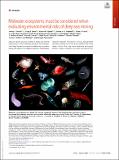| dc.contributor.author | Drazen, Jeffrey C. | |
| dc.contributor.author | Smith, Craig R. | |
| dc.contributor.author | Gjerde, Kristina M. | |
| dc.contributor.author | Haddock, Steven H. D. | |
| dc.contributor.author | Carter, Glenn S. | |
| dc.contributor.author | Choy, C. Anela | |
| dc.contributor.author | Clark, Malcolm R. | |
| dc.contributor.author | Dutrieux, Pierre | |
| dc.contributor.author | Goetze, Erica | |
| dc.contributor.author | Hauton, Chris | |
| dc.contributor.author | Hatta, Mariko | |
| dc.contributor.author | Koslow, J. Anthony | |
| dc.contributor.author | Leitner, Astrid B. | |
| dc.contributor.author | Pacini, Aude | |
| dc.contributor.author | Perelman, Jessica N. | |
| dc.contributor.author | Peacock, Thomas | |
| dc.contributor.author | Sutton, Tracey T. | |
| dc.contributor.author | Watling, Les | |
| dc.contributor.author | Yamamoto, Hiroyuki | |
| dc.date.accessioned | 2020-08-17T16:28:11Z | |
| dc.date.available | 2020-08-17T16:28:11Z | |
| dc.date.issued | 2020-07 | |
| dc.identifier.issn | 0027-8424 | |
| dc.identifier.issn | 1091-6490 | |
| dc.identifier.uri | https://hdl.handle.net/1721.1/126624 | |
| dc.description.abstract | Despite rapidly growing interest in deep-sea mineral exploitation, environmental research and management have focused on impacts to seafloor environments, paying little attention to pelagic ecosystems. Nonetheless, research indicates that seafloor mining will generate sediment plumes and noise at the seabed and in the water column that may have extensive ecological effects in deep midwaters (1), which can extend from an approximate depth of 200 meters to 5 kilometers. Deep midwater ecosystems represent more than 90% of the biosphere (2), contain fish biomass 100 times greater than the global annual fish catch (3), connect shallow and deep-sea ecosystems, and play key roles in carbon export (4), nutrient regeneration, and provisioning of harvestable fish stocks (5). These ecosystem services, as well as biodiversity, could be negatively affected by mining. Here we argue that deep-sea mining poses significant risks to midwater ecosystems and suggest how these risks could be evaluated more comprehensively to enable environmental resource managers and society at large to decide whether and how deep-sea mining should proceed. | en_US |
| dc.language.iso | en | |
| dc.publisher | National Academy of Sciences | en_US |
| dc.relation.isversionof | http://dx.doi.org/10.1073/pnas.2011914117 | en_US |
| dc.rights | Article is made available in accordance with the publisher's policy and may be subject to US copyright law. Please refer to the publisher's site for terms of use. | en_US |
| dc.source | PNAS | en_US |
| dc.title | Opinion: Midwater ecosystems must be considered when evaluating environmental risks of deep-sea mining | en_US |
| dc.type | Article | en_US |
| dc.identifier.citation | Drazen, Jeffrey C. et al. "Opinion: Midwater ecosystems must be considered when evaluating environmental risks of deep-sea mining." Proceedings of the National Academy of Sciences 117, 30 (July 2020): 17455-17460 © 2020 National Academy of Sciences | en_US |
| dc.contributor.department | Massachusetts Institute of Technology. Department of Mechanical Engineering | en_US |
| dc.relation.journal | Proceedings of the National Academy of Sciences | en_US |
| dc.eprint.version | Final published version | en_US |
| dc.type.uri | http://purl.org/eprint/type/JournalArticle | en_US |
| eprint.status | http://purl.org/eprint/status/PeerReviewed | en_US |
| dc.date.updated | 2020-07-31T15:25:12Z | |
| dspace.date.submission | 2020-07-31T15:25:14Z | |
| mit.journal.volume | 117 | en_US |
| mit.journal.issue | 30 | en_US |
| mit.license | PUBLISHER_POLICY | |
| mit.metadata.status | Complete | |
